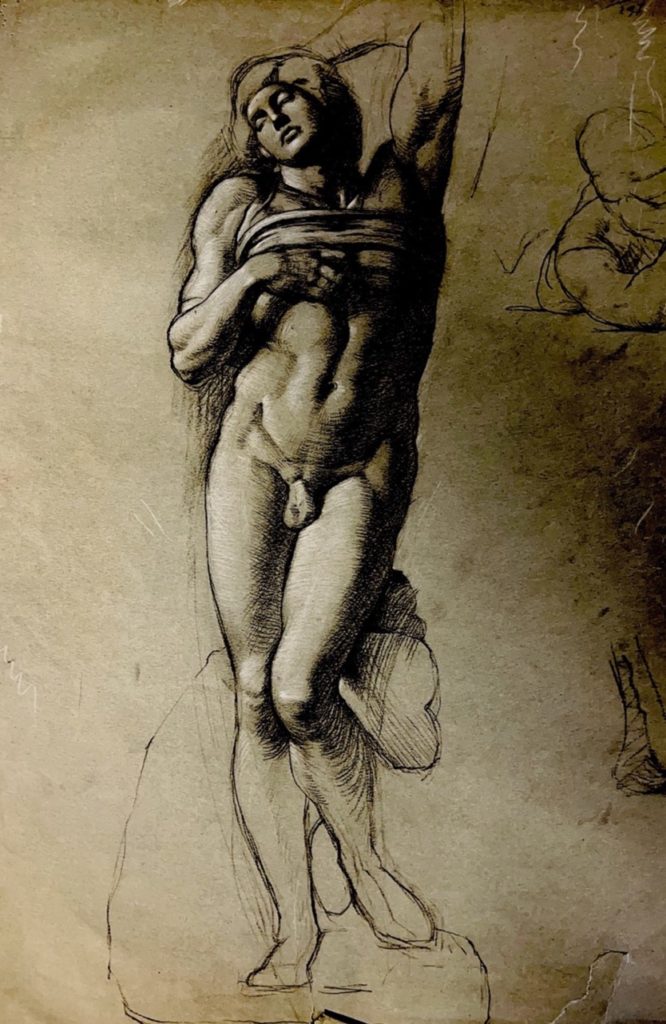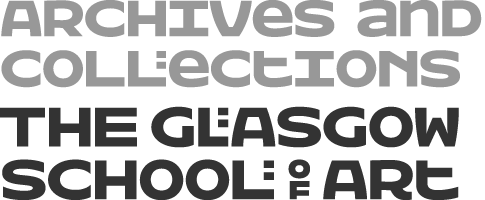Written by Hyeonseo Heather Park, a work placement student from MLitt Art History at University of Glasgow.
Exploring archived collections often uncovers exciting discoveries—works of art created by artists who once brought vibrant creativity to the very city we call home. Ninety years ago, a young student began his artistic journey at The Glasgow School of Art: Gerard V. Murphy. Let us imagine encountering him on campus of today. Although unfamiliar with his story, we could start to uncover the mystery by striking up a conversation. “What are you so passionately drawing, Gerard?”
The Gerard V. Murphy collection is a treasure trove of loose drawings, graphic designs, and teaching materials created by the artist in the 1930s. Murphy was a former student at The Glasgow School of Art, enrolling in September 1934. During his time at the school, he delved into various fine art and design subjects, including plant drawing, historic ornament, lettering, book binding, architecture, and composition, as part of GSA’s four-year curriculum.
He consistently attended drawing classes for four years, focusing on refining his pencil sketching techniques. As a result of honing his skills, the most exquisite piece among his life sketches—likely created between 1936 and 1937—is a striking full-length drawing of a male figure captured in a rather unique pose.

Given that over one-third of Murphy’s collection comprises life drawings and anatomy studies, it is clear that he was particularly focused on figure studies around that time. One of his anatomy drawings is especially striking, featuring a detailed exploration of muscle placement in a head.

According to the GSA student record, Murphy was awarded a minor travel scholarship from the Department of Drawing and Painting in 1937 and won the Robertson & Co Prize in 1935. These achievements were clearly a product of his persistence and diligence.
Murphy was a Scotland-based artist throughout his life, having been born in 1914 in Hamilton, Scotland, and never having relocated abroad.
As seen in Figure 3, his pattern designs are characterised by distinctive curves and a selection of unique combinations of colours, the flowing lines of the plants are reminiscent of Art Nouveau.

It can be observed that his pattern designs were influenced by earlier Scottish artists who embraced the aesthetic principles of the Arts and Crafts movement. At that time, the city of Glasgow, stood out as a strong example of cultural regeneration and in the movement toward applied arts. Like many fellow artists of his time, Murphy’s patterns were primarily intended for textiles and wallpaper designs. In line with the legacy of the Arts and Crafts movement, which drew inspiration from natural forms, each element on a single plate appears to be organically and tightly interconnected. Though influenced by established nature-inspired design principles, Murphy confidently developed his own graphic style.

In 1938, Murphy was awarded the Diploma in Drawing and Painting from the GSA. After completing his studies there, likely by the early 1940s, he began a new career as an art teacher in schools. His involvement in teaching art across Scotland reflects his keen dedication to art education within the local community. He worked across the country, and in particular at Motherwell Roman Catholic High School (now Our Lady’s High School), Coatbridge Secondary School, and Airdrie Academy.
Building upon the bookbinding and lettering techniques learned during his time at GSA, he led sessions on designing posters and cover art for students’ extracurricular activities. His teaching material from this time is specially noteworthy, showcasing his interest in woodblock printmaking. One of his prints (Figure 4) also reveal the influence of the Celtic revival. In the 1930s, Glasgow-based designers were often inspired by their common Celtic heritage, this trend is also evident in Murphy’s printworks.
Revisiting works of art in collections and archives it is almost like a continuous dialogue between the researcher and the artist. During this journey, we are presented with numerous ‘ways of seeing’ artworks, delving into the artistic realms that captured an individual’s interest can be an extremely joyful experience. In doing so, we continue an ongoing conversation with the artists, fostering a connection rooted in affection and appreciation of their work.
You can find more about the work of Gerard V. Murphy on GSA Archives & Collections online catalogue.
Bibliography
Billcliffe, Roger. “A Brush with Europe: Visual Art in Glasgow 1890-1990.” RSA Journal 139, no. 5417 (1991): 330-342.
Cumming, Elizabeth, Andrew McCormick, and Rijksmuseum. Glasgow 1900: Art & Design. Zwolle, Amsterdam, Waanders, 1992.
Macdonald, Murdo. Scottish Art. London: Thames & Hudson, 2000.
